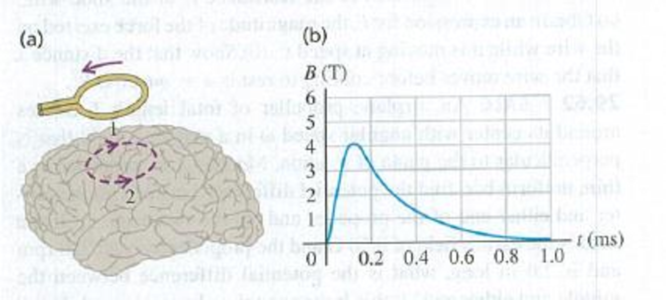
BIO STIMULATING THE BRAIN. Communication in the nervous system is based on the propagation of electrical signals called action potentials along axons, which are extensions of nerve cells (see the Passage Problems in Chapter 26). Action potentials are generated when the electric potential difference across the membrane of the nerve cell changes: Specifically, the inside of the cell becomes more positive. Researchers in clinical medicine and neurobiology cannot stimulate nerves (even noninvasively) at specific locations in conscious human subjects. Using electrodes to apply current to the skin is painful and requires large currents, which could be dangerous.
Anthony Barker and colleagues at the University of Sheffield in England developed a technique called transcranial magnetic stimulation (TMS). In this widely used procedure, a coil positioned near the skull produces a time-varying magnetic field that induces in the

29.71 In part (a) of the figure, a current pulse increases to a peak and then decreases to zero in the direction shown in the stimulating coil. What will be the direction of the induced current (dashed line) in the brain tissue? (a) 1; (b) 2; (c) 1 while the current increases in the stimulating coil, 2 while the current decreases; (d) 2 while the current increases in the stimulating coil, 1 while the current decreases.
29.71 IDENTIFY and SET UP: Apply Lenz’s law to determine the direction of the induced current. The figure shows the current pulse in the coil is in the counterclockwise direction as viewed from above. Also, the figure shows that direction-1 for the induced current is clockwise and direction-2 is counterclockwise.
EXECUTE: As the current pulse increases, it produces an increasing upward magnetic field in the brain.
To oppose the increasing flux, the induced current must flow clockwise (direction-1). As the current pulse decreases its upward magnetic field decreases and the induced current must flow counterclockwise (direction-2) to oppose this. The correct choice is (c).
EVALUATE: Although the brain is made up of tissue, in some ways it behaves like a resistor and allows current to flow in it.
Want to see the full answer?
Check out a sample textbook solution
Chapter 29 Solutions
Mastering Physics with Pearson eText -- Standalone Access Card -- for University Physics with Modern Physics (14th Edition)
Additional Science Textbook Solutions
Chemistry: The Central Science (14th Edition)
Microbiology with Diseases by Body System (5th Edition)
Introductory Chemistry (6th Edition)
Genetic Analysis: An Integrated Approach (3rd Edition)
Human Anatomy & Physiology (2nd Edition)
Campbell Biology: Concepts & Connections (9th Edition)
- I need correct answer not chatgptarrow_forwardWhat is the resistance (in (2) of a 27.5 m long piece of 17 gauge copper wire having a 1.150 mm diameter? 0.445 ΧΩarrow_forwardFind the ratio of the diameter of silver to iron wire, if they have the same resistance per unit length (as they might in household wiring). d. Ag dFe = 2.47 ×arrow_forward
- Find the ratio of the diameter of silver to iron wire, if they have the same resistance per unit length (as they might in household wiring). d Ag = 2.51 dFe ×arrow_forwardShow that the units 1 v2/Q = 1 W, as implied by the equation P = V²/R. Starting with the equation P = V²/R, we can get an expression for a watt in terms of voltage and resistance. The units for voltage, V, are equivalent to [? v2 v2 A, are equivalent to J/C ✓ X . Therefore, 1 = 1 = 1 A V1 J/s Ω V-A X = 1 W. . The units for resistance, Q, are equivalent to ? The units for current,arrow_forwardPlease solve and answer the question correctly please. Thank you!!arrow_forward
 College PhysicsPhysicsISBN:9781305952300Author:Raymond A. Serway, Chris VuillePublisher:Cengage Learning
College PhysicsPhysicsISBN:9781305952300Author:Raymond A. Serway, Chris VuillePublisher:Cengage Learning College PhysicsPhysicsISBN:9781938168000Author:Paul Peter Urone, Roger HinrichsPublisher:OpenStax College
College PhysicsPhysicsISBN:9781938168000Author:Paul Peter Urone, Roger HinrichsPublisher:OpenStax College
 Physics for Scientists and Engineers: Foundations...PhysicsISBN:9781133939146Author:Katz, Debora M.Publisher:Cengage Learning
Physics for Scientists and Engineers: Foundations...PhysicsISBN:9781133939146Author:Katz, Debora M.Publisher:Cengage Learning College PhysicsPhysicsISBN:9781285737027Author:Raymond A. Serway, Chris VuillePublisher:Cengage Learning
College PhysicsPhysicsISBN:9781285737027Author:Raymond A. Serway, Chris VuillePublisher:Cengage Learning Physics for Scientists and Engineers, Technology ...PhysicsISBN:9781305116399Author:Raymond A. Serway, John W. JewettPublisher:Cengage Learning
Physics for Scientists and Engineers, Technology ...PhysicsISBN:9781305116399Author:Raymond A. Serway, John W. JewettPublisher:Cengage Learning





